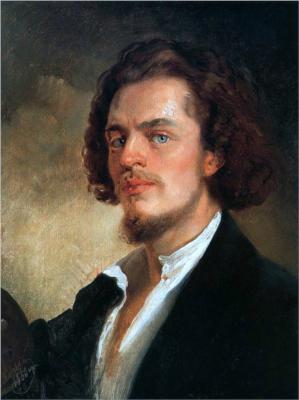

Konstantin Makovsky
RU
47
Artworks
1839 - 1915
Lifespan
Artist Biography
Konstantin Yegorovich Makovsky (1839–1915) was a distinguished Russian painter renowned for his vibrant historical scenes and society portraits, embodying a bridge between academic traditions and emerging realist and impressionistic trends. Born in Moscow into an artistic family – his father, Egor Makovsky, was an amateur painter and co-founder of the Moscow Art School, and his mother was a composer – Makovsky was immersed in a creative environment from a young age. This upbringing fostered his early interests in both painting and music. At the age of twelve, he enrolled in the Moscow School of Painting, Sculpture and Architecture, where he excelled under the tutelage of artists like Vasily Tropinin and Karl Bryullov, whose romantic and decorative influences would subtly shape his later work.
In 1858, Makovsky furthered his artistic education by entering the prestigious Imperial Academy of Arts in Saint Petersburg. During this period, he produced significant early works such as "Curing of the Blind" (1860) and "Agents of the False Dmitry kill the son of Boris Godunov" (1862). However, his tenure at the Academy was marked by a pivotal act of rebellion. In 1863, Makovsky, alongside thirteen other students, protested the Academy's rigid thematic restrictions for the Large Gold Medal competition, which mandated subjects from Scandinavian mythology. This "Revolt of the Fourteen" led to their collective departure from the Academy without formal diplomas, a bold statement against academic conservatism.
Following his departure from the Academy, Makovsky became a key figure in the burgeoning realist movement. He joined the Artel of Artists, a cooperative led by Ivan Kramskoi, and later became a founding member of the influential "Peredvizhniki" (The Wanderers, or Society for Travelling Art Exhibitions) in 1870. This group advocated for art that depicted the everyday life and social realities of Russia. Works from this period, such as "The Widow" (1865) and "The Herringwoman" (1867), reflect this commitment. A significant stylistic evolution occurred in the mid-1870s following his travels to Egypt, Serbia, and North Africa. These journeys inspired a greater emphasis on vivid colors, light, and form in his paintings, moving beyond purely social themes.
The 1880s marked the zenith of Makovsky's career, as he became one of Russia's most fashionable, highly-paid, and respected artists, often dubbed "The Tsar's Painter" due to his portraits of three generations of the Romanovs. He gained international acclaim for his large-scale historical paintings that presented an idealized and opulent vision of pre-Petrine Russia. Masterpieces like "A Boyar Wedding Feast" (1883), "The Russian Bride's Attire" (also known as "Beneath the Crown," 1889), and "Choosing the Bride" captured the public's imagination with their rich detail, elaborate costumes, and dramatic compositions. To ensure authenticity, Makovsky amassed a significant collection of antiques, textiles, and traditional Russian attire, which he used as props. His success was crowned at the 1889 Paris World's Fair, where he received the Large Gold Medal for "Death of Ivan the Terrible," "The Judgement of Paris," and "Demon and Tamara."
Makovsky's artistic style was a complex fusion. While rooted in academic training, his work increasingly incorporated qualities associated with Impressionism, particularly in his handling of light and color, leading some critics to view him as a forerunner of Russian Impressionism. He also produced Salon art, appealing to a broad and appreciative audience. His fame extended to America, where he traveled in 1901 and painted a portrait of President Theodore Roosevelt. His personal life saw him marry three times, with his second wife Julia Letkova and third wife Maria Matavtina often serving as muses.
Konstantin Makovsky's prolific career was tragically cut short in 1915 when he died in Saint Petersburg from injuries sustained in a traffic accident, his horse-drawn carriage struck by an electric tram. While the subsequent rise of avant-garde movements like those led by Malevich and Kandinsky would temporarily overshadow his more traditional style, Makovsky's legacy endures. He remains celebrated for his captivating depictions of Russian history and high society, his technical skill, and his role in the dynamic artistic landscape of 19th-century Russia, with recent exhibitions and scholarship reaffirming his importance.